The roll of the Medical Corps in WW1
The operating room aboard the USS MercyThe Uss Mercy was the first completely equipped hospital ship in the US Navy. She made four trips across the Atlantic bringing home almost 2,000 wounded men.
Mobilizing the Medical Corps for WW1
America was unprepared for the medical demands of war during the Spanish-American War. The resulting high losses caused a public outcry and the Army Medical Department was organized in 1901 in response.
See Base Hospital 32
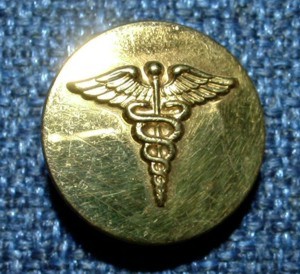
WW1 Medical Corps Collar Insignia
Indiana War Memorial Collections
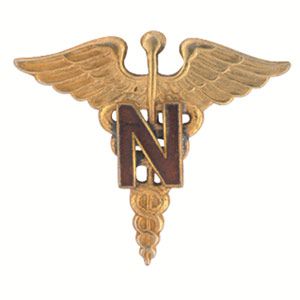
Army Nurse Corps
Caduceus Pin
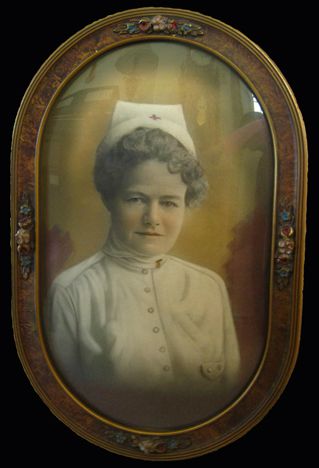
Agnes Swift
A nurse with Base Hospital 32
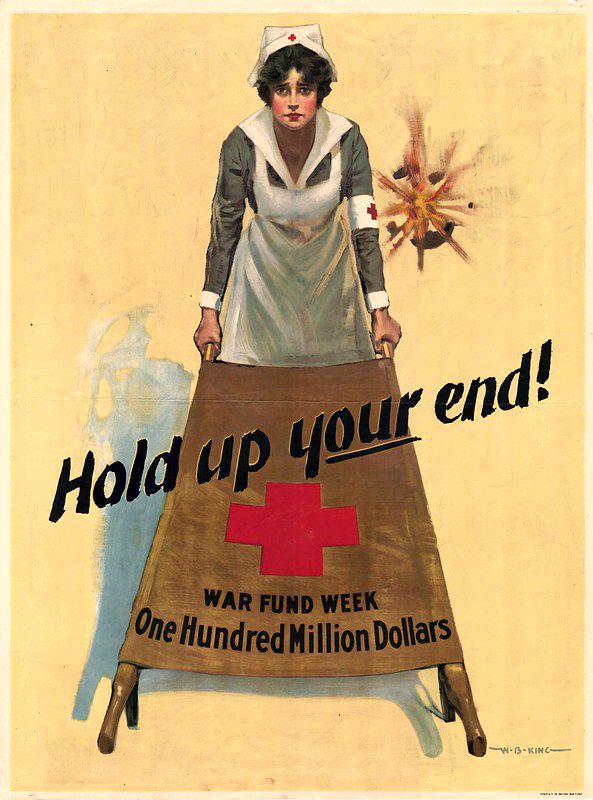
WW1 Recruiting Poster
US Army Signal Corps
"You can’t imagine how awful it is. We thought we knew about war when we were in the other sector as we took in different parts of the front. Our first few months seemed more a picnic than anything else. It is no fun traveling around with attacking division.
“We are back in a place for we can get ahold of baths again. My, that is good news! And we've gotten very good quarters too. It's a little better than sleeping in an old, rickety barn, on moldy straw, with lice, mice, and rats running over you, bombs, shells, bullets bursting within 10 to 50 ft. from you, and waking up in the middle of the night to put on your gas mask. We have been through all that (and) the memories aren't very pleasant.”
Andrew Milburn Meek , 2nd Lt.,
152nd Ambulance Company,
Medical Corps,
Grant County, Indiana
“Learned to love rattlesnakes and eat sand while training in the pine forests of Mississippi.”
Mabel Charlotte McCartney
Lake County, Indiana,
Army Nurse Corps
" Sherman was right."
Valley Virginia Boyer
Laboratory Technician, Medical Corps,
Tippecanoe County, Indiana
Entered service July 2, 1918. Stationed at Camp Cody. N. M., as bacteriologist and chemist in Base Hospital laboratory, also Division Agent on Bureau of Civilian Relief, Mountain Division of American Red Cross, in Post War Work, at Denver Colo. Received discharge from Medical Department of the army, January 27, 1919, and left immediately for Denver to take up work with the American Red Cross. Born at Lafayette, Ind., Jan 4, 1884, daughter of S. H. P. and Amanda C. Boyer. Graduate of LaFayette high school, Chautauqua School of Physical Education, Chautauqua N. Y., and Purdue University. Home is LaFayette. Ind.
Willys Peck Wagner, Medical Corps, Vigo County, Indiana
“Still strongly against compulsory military service excepting case of actual invasion. Would like to see all armies completely abolished.”
Unloading a stretcher case from a truck. Evac hospital No. 6-7, near Souilly, Meuse, France.
National Archives photo 24490 Group 111
WW1 Ambulance Train
US Signal Corps photo 24770
Indiana War Memorial
Ross Bradley Bretz, Medical Corps, Physician,
Vanderburg County, Indiana
- Medical Officers Training Camp, Fort Riley, Kansas
- Infantry School of Fire, School of Gas Warfare, Fort Sill, Oklahoma
- Director, Gas Defense, Fort Snelling, Minnesota.
- Adjutant to attending surgeon, Headquarters, Central Department, Chicago, Illinois
- Member of Officers Disability Board, Special Intelligence Officer
- Field Hospital Co. 351, 313th Sanitary Train, 88th Div., Camp Dodge, Iowa
- School for treatment of Shock and Hemorrhage, Dijon, Cote d’Or, France
- Field Hospital Co. #352, Romangny, France, treatment of gassed cases.
- Battalion Gas Officer, 313th Sanitary Train
- Base Hospital #15, Chaumont, France
- First Depot Division, St. Aignon, France
- Camp Hospital #49, Laignes, Cote d’ Or, France
- Officer Chief Surgeon, Advanced Section, Neuf Château
- Post Hospital, Romagne, France (Argonne Cemetery)
- Infirmary, Motor Transport Corps, Reception Park, Bourg, Haute Marne
- Commanding Officer, Medical Detachment, 426th Motor Supply Train
- Troop Surgeon, USS Montpelier
Joseph Hamilton Weinstein, Captain, Surgeon,
Medical Corps,
Vigo County, Indiana
"Regularity of camp life improved my health and increased my weight, but only increased my dislike military and its methods.
Hard work and irregular hours took off all I had gained until long after the Armistice, my dislike for a military life was only increased. I really insist things must be and the military must exist, unfortunately- that such methods are the only ones which such numbers of men can be handled. I am more bitterly opposed an effort to war, yet when duty calls in the country is in need of my services, they were and will be freely and cheerfully given."
Katherine R. Kreutzer, Nurse, Miami County, Indiana
"interesting experiences: Leave spent at Nice and Mentone. Visited battlefields, Verdun, Argonne Forest, Montfaucon, Romagna Cemetery, Joan of Arc's home. So unsettling after returning but I could easily have reenlisted. Everyone I heard from felt the same way. Soon I was myself once more"
Evelyn Potter
Parke County, Indiana
Army Nurse Corps
"Ghastly"
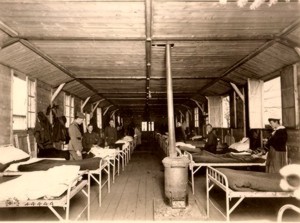
Camp Hospital 7, Humes France
National Archives Photo, Indiana War Memorial
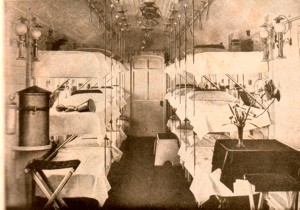
Inside a hospital train car
America's War for Humanities
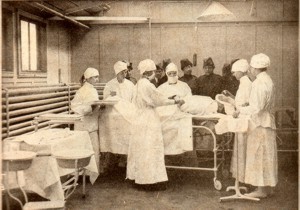
Women doctors at an American Base Hospital in France giving skillful and tender treatment to American wounded. More than 2,000 women physicians and surgeons serve these hospitals under the Red Cross.
America's War for Humanities
Iva Lehman, Nurse, Whitley County, Indiana
"Anyone who is actively interested in the war, especially those of us who saw its results from the physical standpoint, can only repeat Sherman when he said, 'War is Hell.' One trip to a government hospital today, 18 years after its close, will prove this to its fullest.
"In spite of the fact that we were provided with rubber boots, and in addition took with us one or two extra pairs of rubbers, we were soon in need of more rubber footwear. Fifty days of continuous rain make the mud almost bottomless, and it was impossible to step out of our quarters without being protected. A few walks were made with broken stones and cinders, but the broken stones were hard on shoes. Many of us wore rubbers issued from the Quartermaster's, but they were so large and heavy that we can scarcely carry them. I went into Nevers one day for the purpose of buying some new rubbers. I saw in a show window, a pair that looked as if I might be able to wear them. After the use of my few broken French words and many gestures, the French girl clerk took the rubbers from the window for me to try. They were fairly good fit; so I took them and paid for them. When I was ready to leave, she picked up my mud-covered rubbers that had very little sole left, smilingly, set them on the counter, and said 'My American souvenir'.
Christmas of 1918 in France was very interesting. All did what they could to make it a merry one, as there were prospects of our soon going home, but Quartermaster issued us a 100 lb. sack of sugar to be made into candy. We were busy every minute when off-duty, for several days, on this job, as we only had an upright heating stove in our quarters, and much of the candy was cooked there. Fuel was very scarce, which added to our difficulties, but we finally accomplish our purpose and made the candy go as far as possible among the boys. Mistletoe grew in abundance, and this was used to decorate the wards. We also had Christmas trees in the wards and at the nurse's home. The Red Cross filled home knitted socks for all the patients with cigarettes, oranges, nuts, and candy. All patients who were able went to Christmas Eve services held at the Red Cross hut. To accommodate the crowds, three services were held, the last at midnight. We attended this one and then went to bed at 4 AM, then many of us put on our white uniforms, which were seldom worn, our caps and capes, and marched through all the wards carrying candles and singing Christmas carols. Later, there was a very nice dinner for the boys, and each ward had a little party of his own. The photograph shows the inner dress-up uniform. Our work uniforms were gray crepe or gingham, with white butcher's aprons. We were often very thankful that they were such, as we had to do our own laundry work. We never learn(ed) to patronize public wash pools; so usually a pail served as a washtub. We were lucky to have hot water. Our ironing was often done by folding the aprons nice and straight and sleeping on them. The uniforms had to be pulled as straight as possible."
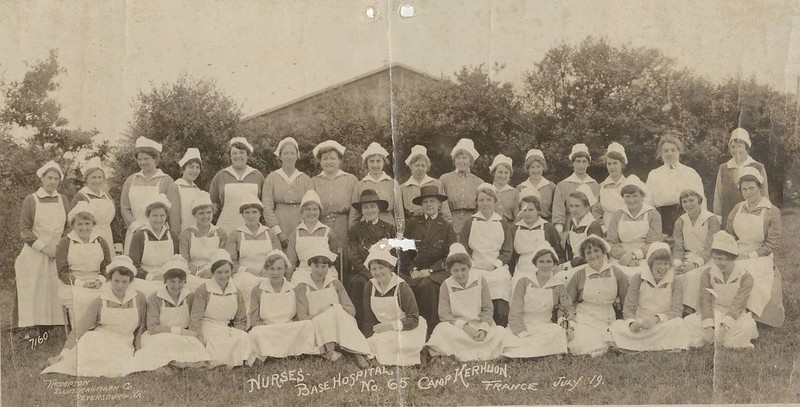
Small panoramic group photograph of the nurses of Base Hospital No. 65 at Camp Kerhuon, France, on July 1919 (July 1919) [Photograph by: Thompson, Illustragraph Company, Petersburg, Virginia] US Army SIgnal Corps
Maude J. Welsh, Army Nurse Corps, Red Cross Nurse,
Cass County, Indiana
"Service in the Army was true to its reputation - one got anything but the type of service requested in enlistment. We, nurses, vowed that in the next war be telephone girls - they seem to get all the breaks - but, of course, we never trade services with them."
Ruth Wright, Army Nurse Corps,
Fulton County, Indiana
Served at General Hospital 1, New York; Embarkation Hosp1, New Jersey; Debarkation Hospital 1, NY; Base Hosp. 32, Contrexeville, France, Hosp. D; detached service w/ field H, 307 & 147; Evacuation Hospital 14, Toul, France & Evacuation Hospital 14, Coblenz, Germany. "Moonlight nights always remind me of air raids'"
Clayton Chauncey Buell, Private,
Allen County Indiana
62nd Bn., Canadian Expeditionary Forces “My nearest relatives have always lived here and because of that, I've always considered Ft. Wayne my home, the only home I have.
The 62nd Battalion was absorbed in England by the 30th reserve, Canadian and was sent in drafts as reinforcements to different units in France, I went with the 29th Battalion and served with them for 21 months when I was transferred to the #1 General hospital, Canadian Army Medical Corps and while there was wounded in an air raid May 19, 1918.
Baruch Mordecai Edlavitch, Indiana, Medical Corps,
Allen County
“Served as a surgeon on five British ships used in transport service and on one Dutch ship.
On arrival at Liverpool on S. S. Tahiti, the ship was taken from our service, and I was returned to the US as assistant Surgeon on S. S. Minnehaha.
After arrival in Liverpool on S. S. Orca, the ship also was taken from our service. Assigned to duty as a surgeon on S. S. Pannonia. After a wait of several weeks, during which his ship was held up, he was transferred to duty in the office of attending surgeon, London, England, a section 2 S. O. S., A. F., and afterward was returned to the US as a surgeon on the Dutch S. S. Noordam.”
ADAH McMAHAN , Medecin in French Army,
Tippecanoe County, Indiana
Entered service Aug. 25.1918, under the auspices of the Women’s Oversea Hospital, USA Unit No.3. which was attached to the Field Ambulance 1-86Z, for treatment of the gassed men of the French army. After the armistice was signed did Civilian Relief work at Epinal and Vosges, France. Born at Huntingburg, Ind., Jan. 12,1869, daughter of William Reed and Louise Elizabeth McMahan. Graduate of Indiana University and Northwestern University. Home is Lafayette.
Nettie Jane Penwell, Army Nurse Corps,
Marion County, Indiana
“Not bad in the United States, terrible abroad, so my brother said. Everything about being in the Army and Red Cross Nurse was interesting; being in the service was the happiest time of my life.”
Russell Henry Mercer, Sergeant, Medical Corps,
Tippecanoe County, Indiana
Entered service June 7, 1917. Was first sent to France, then transferred to England. Was in Scotland with secret service and later at Cardiff, Wales. Was born in Illinois, son of Sanford N. and Letty Mercer. Graduated from Weidner Institute. Home is at Mulberry, Ind.
Rosa Mary Rapp, Army Nurse Corps, Gold Star,
Clinton County, Indiana
Her portrait hangs in the Historical Building, Frankfort, Kentucky. Louisville City Hospital Alumnae has a Rosa Rapp fund to loan to nurses in training.
Alice Thompson
Benton County Indiana
Army Nurse Corps
"war is unadulterated hell. Nurses were held in high esteem by their associates in the Army. I always felt that every one of the thousands of men at Fort Riley was my bodyguard."
Wilma Wallace
Marion County, Indiana
Army Nurse Corps
"My greatest impression was the appreciation the boy showed for everything that was done for them."
Belle Catherine Smith
St. Joseph County, Indiana
American Red Cross Nurse
"One amusing thing connected with my service record is that in the recorder's office of St. Joseph County, Indiana, where I had a permanent record of my service and discharge papers filed, I shall go down in posterity as 'Reverse nurse' instead of Reserve Nurse! As the papers were lengthy and I did not read them over carefully for some time afterward, the error was not discovered until too late to be rectified."
Mary Loraine Wendling, Army Nurse Corps,
Knox County, Indiana
" I liked my work.... We should pray for peace every day." Amusing: "Nurses drilling and attending Revelry at 6 AM."
Ted Raymond Wesler, Medical Corps, France,
Ripley County, Indiana
“In August 1918, Private Wesler volunteered to give some of his blood for transfusion. Was off duty for a day for this operation.
“War service: was a nurse in the wards of the 4th Evacuation hospital. This hospital was bombed from an airplane on July 18, 1918, but no damage sustained, the bomb falling in an adjacent wheat field.
“When wounded on November 2, 1918, the guns were evidently aimed at the hospital but five shells fell harmlessly between the adjacent village and the hospital. Three struck the billet where fifteen soldiers were sleeping. Two sergeants were killed, nine privates, and one major were wounded, all receiving severe wounds.”
Mary Lynn Swain, Army Nurse Corps,
Henry County, Indiana
"Unit C was the first outfit in Château Thierry after the Germans left. Have a citation for bravery under shell fire."
Pauline E. Pfafman, Army Nurse Corps,
Noble County, Indiana
“My most lasting impression of the war years was when 600 nurses and soldiers marched in uniform to the cemetery on Memorial Day to decorate our departed boys’ graves.”
"Army Nurses Lie in Far off France." Army nurses' graves are always decorated by grateful hands." US Official Photo, Indiana War Memorial
Florence J. Martin, Army Nurse Corps,
Clark County, Indiana
Awarded the Medaille d'Honneur des Epidemics
by the Minister of War, France.
The Medal of Honor, Epidemics is rewarded those who had particularly distinguished themselves by their dedication during periods of epidemic diseases:
- Exposed to dangers of contamination, providing care to patients with contagious diseases;
- Preserving, in a personal and noteworthy, territory or place of the invasion of a disease epidemic;
- Helping to spread or participating in disinfection operations, during an epidemic.
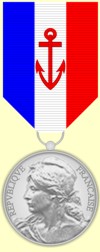
ADAH McMAHAN, Medecin in French Army,
Tippecanoe County, Indiana
Entered service Aug. 25.1918, under the auspices of the Women’s Oversea Hospital, USA Unit No.3. which was attached to the Field Ambulance 1-86Z, for treatment of the gassed men of the French army. After the armistice was signed I did Civilian Relief work at Epinal and Vosges, France. Born at Huntingburg, Ind., Jan. 12,1869, daughter of William Reed and Louise Elizabeth McMahan. Graduate of Indiana University and Northwestern University. Home is Lafayette.
Scott Kelsey Henderson, Base Hospital #54,
Ripley County, Indiana
“Had as many as 2,750 patients during the heavy fighting, though supposed to accommodate only 1,040. Officers turned out of mess-hall so as to fill it with cots. The personnel of the hospital consisted of 185 men and 40 nurses.”
Ella Hand, Red Cross Nurse,
Madison County, Indiana
"The first impression of the war was the marked activity everywhere, due to the love and loyalty everyone had for our country and the desire to serve in so great a cause. when our boys began to return, no one noticed there was disillusionment. Sadness, that the country they loved had to go to such thing as war and cause so much cruelty and suffering. Let us pray that our country keeps peace always.
A dear buddy, delirious from flu, bit me on the wrist when I was giving him a hypodermic injection. He was out to fight the Huns. He recovered and was told about it and sent me an apology. Bless his heart."
Mary Kennedy, Nurse,
Dearborn County, Indiana
"An interesting period for new adventures, taking hardships and seeing folks pass on to the great beyond, not knowing what it was all about. At one time on my floor of our hospital, we were caring for American soldiers, French soldiers, and German prisoners of war."
ROY M. ZUFALL, Private, Ambulance Corps,
Tippecanoe County, Indiana
Croix de Guerre: Entered service in July 1917, a member of Purdue Ambulance Corps. Sailed for overseas in January and landed in England and was later sent to France. Was awarded the Croix de Guerre. Born in Lafayette, May 16, 1891, son of Elizah and Mary N. Zufall. Educated in Lafayette schools and Purdue University. Wife is Florence Becker Zufall. Home is Lafayette.
Robert William Batdorff, 150th Field Hosp.,
Hamilton County, Indiana
Sergeant, Indiana Field Hospital #2, 113th Sanitary Train, 38th Division (unit later renamed the 150th Field Hospital)
“Organization used as replacements after signing of the armistice. Was originally made up of Noblesville, Frankfort, Lafayette, and Bloomington boys. Major G F Holland (Bloomington) in command, Captain George D. Haworth, second in command. Unit mobilized at Frankfort, Indiana August 5, 1917, trained there until September 13, 1917. Entrained for Camp Shelby, Mississippi, September 13, 1917, and September 15, 1917. Only two deaths during service in this company, both from disease.
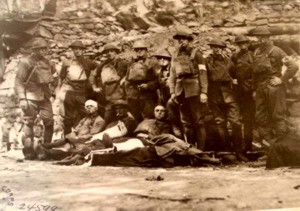
Members of the first aid station of the 137th Ambulance Co.
Camp Germany.
US Signal Corps photo,
Indiana War Memorial
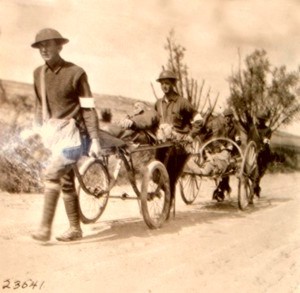
National Archives photo courtesy of Indiana War Memorial
Merritte Weber Ireland
Whitley County, Indiana
Distinguished Service Cross:
"As chief surgeon of the American Expeditionary Forces he supervised and perfected the organization of the medical department in France; and to his excellent judgment, untiring efforts, and high professional attainments are largely due to the splendid efficiency with which the sick and wounded of the American Army have been cared for."
Robert Thompson Millspaugh,
Goldstar,
Pfc, Medical Corps,
Grant County, Indiana
Robert T. Millspaugh enlisted in June 1916, when the trouble was growing on the Mexican border. He saw that we were going to be in the war and did not want it to be said of him that he waited for the draft and so enlisted early. He was not strong and his family feared to have him go, as they felt he could not endure the exposure, but he insisted that it was his duty to try and that if he should die, it would be just as easy in the Army as elsewhere. He gave himself freely to the service of his country and paid sacrifice of his life.”
Alice S. Knight
American Red Cross Nurse
Allen County, Indiana
"My roommate and I appropriated a can of petrol from the ambulance company and really laundered our hair. We appeared with Marcel's next day in spite of the muddy, bloody Marne. (Marcel is a Veronica Lake wavy hairdo) as a result, I was made hairdresser to our head nurse but sworn to secrecy.
'The Spite Attack' & 'Behind the Lines', by Elizabeth Fraser, in the Saturday Evening Post, written about our hospital. Our head nurse, Linda Myers, was one of the few awarded the Florence Nightingale medal. Unless one finds a group of kindred souls can still remember the funny things, in spite of the poor, and is not offended by the crudeness of the jokes, they are better kept in one's memory until one of those rare reunions."
Jesse Maple Van der Plaat
Army Nurse Corps
White County, Indiana
"The war seems to be something terrible, and when the boys were coming back to camp crippled it made us very sad."
Amusing incident: " one evening a bunch of us nurses to our lunch and with some privates ( nurses were not allowed to go out with privates) went on a train to some little burg and had a picnic. When we were ready to go back to camp, we had no way to ride. The boys held in the auto which took us in. When we got nearly to camp, I told the driver to let us out as we didn't want to be caught with him or the boys. He replied 'Sure. I don't want to be caught with you either!' He had no taxi license it was not supposed to carry passengers."
Josephine Suwalska Jokaitis,
Chief Nurse,
Red Cross Commission in Poland
"On a bitter winter day, after a heavy snowfall, I saw a detachment of courageous young Polish soldiers marching. Many of them were shoeless, their feet bound with tree bark and rags, but they went along singing cheerfully. Another thing brought to mind when I hear people complaining of deprivations is the many ragged and hungry refugees in eastern Poland; their homes in ruins, and they would come to the American Red Cross on foot from miles away, grateful for a bowl of soup and a slice of bread in medical aid.
Flora Jane Middleton, Army Nurse Corps,
Carroll County, Indiana
"One of the deepest impressions left on my mind with the way the soldiers faced their wrecked lives. Shattered in mind and body, they were cheerful and brave. They would sing 'My left lung lies over the Ocean' to the tune of 'My Bonnie'."
Catherine Agnes Schilling,
Newton County, Indiana
Army Nurse Corps
"This hospital was a beautiful hotel belonging to Mrs. Vanderbilt, and her estate was close by. She turned this over to our boys returning from overseas, and the small cottages housed hundreds of our nurses. I served as a night nurse for a while on the officer's Board. We had the youngest captain in the Army, just 21. Almost all of the commissioned officers were very young."
Mary E. Seeman, Army Nurse Corps,
Wayne County, Indiana
Served in Oklahoma and Puerto Rico: “There were 15 nurses in our unit. I did not care for the natives of Puerto Rico, they were sneaky and treacherous and did not like the Americans. There were several earthquakes, with some more severe than others. During one quake, before we nurses knew what it was all about, our sickest patients, fresh operative cases, were up out of bed, running to get out in the open.”
Lillian Dell Seneff. Army Nurse Corps,
Orange County, Indiana
“Dreadful to see men dying with flu. How happy the boys were to be back, some with fingers gone; some legs and arms; some, minds gone.
Mary Alice Shoemaker
Lake County, Indiana
Army Nurse Corps
"Consider myself very fortunate in being a nurse and being able to be of service during the war. The work was its own reward."
Lillian Neale Welker
Posey County, Indiana
Army Nurse Corps
"Readiness of soldiers to obey orders was wonderful! I hope our good old USA will never have need of such things as trenches again."
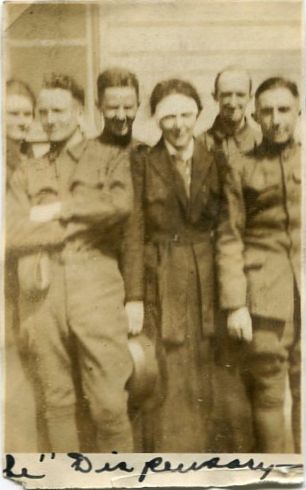
Snapshot of an unidentified injured U.S. Army nurse [believed to be Rosalie A. Ferguson of Siler City and Kinston, N.C.], with a bandage around her head, posing outside of a building with unidentified U.S. Army soldiers at the U.S. Army’s Base Hospital No. 65 in Kerhuon, France, during World War I. The men are believed to have been serving in the hospital’s dispensary (undated).
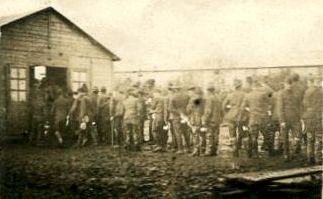
Snapshot of a line of U.S. Army soldiers, some of which are injured and recovering, standing outside of a building believed to be a mess hall appearing to be waiting for a meal at the U.S. Army’s Base Hospital No. 65 in Kerhuon, France, during World War I. The men are holding their Army mess kits. Some of the men are seen using crutches [circa 1918].
US Army Signal Corps Photo
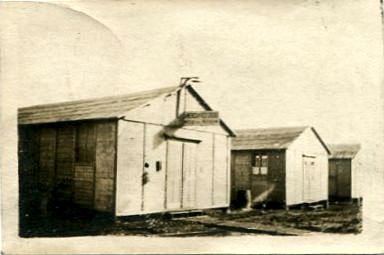
Snapshot of the American Red Cross Club for Nurses building at the U.S. Army’s Base Hospital No. 65 in Kerhuon, France, during World War I. Two other unidentified hospital camp buildings are pictured [circa 1918].
US Army Signal Corps photo
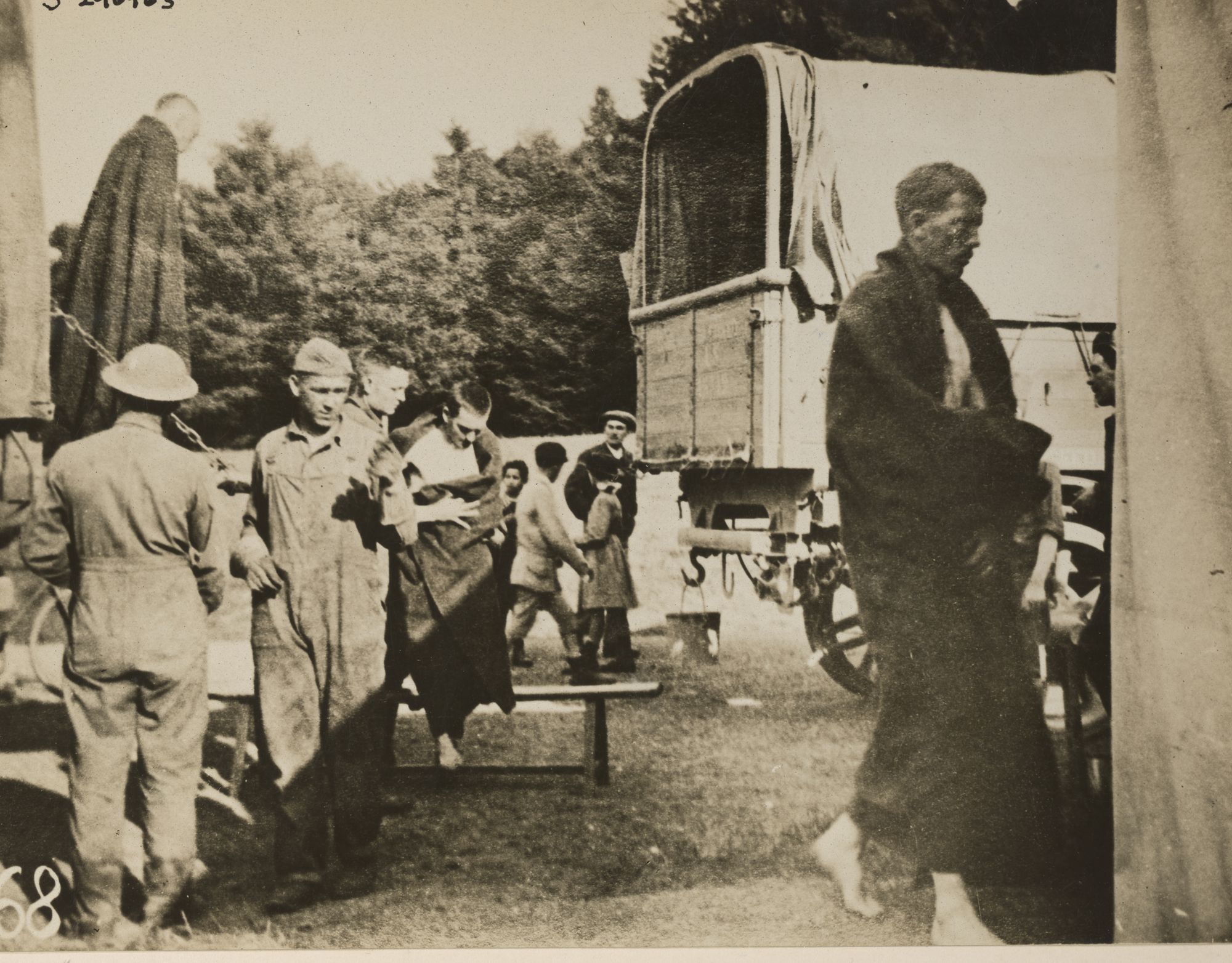
American soldiers who have been gassed arriving at hospital at Jouy, France. The day before the photograph was taken, the Germans bombed it and killed some of the wounded
National Archives #45493964
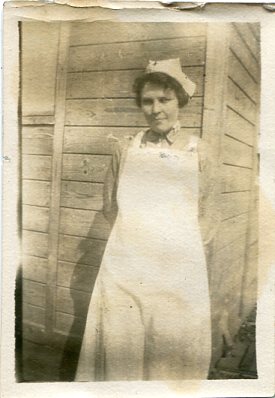
Snapshot of U.S. Army Nurse Corps nurse Rosalie A. Ferguson of Siler City and Kinston, N.C., wearing a white nurse’s apron, standing outside at the corner of a building at the U.S. Army’s Base Hospital No. 65 in Kerhuon, France, during World War I. Part of the caption on the back of the photograph that is readable is “I have [never] looked this solemn” [circa 1918].
US Army Signal Corps photo
![MCReal-photo postcard of a section of the hospital at Camp Bragg, N.C., taken between 1918 and 1922 [circa 1918-1922]. MCReal-photo postcard of a section of the hospital at Camp Bragg, N.C., taken between 1918 and 1922 [circa 1918-1922].](https://wwvets.org/wp-content/uploads/2020/08/MCReal-photo-postcard-of-a-section-of-the-hospital-at-Camp-Bragg-N.C.-taken-between-1918-and-1922-circa-1918-1922.-1.jpg)
Real-photo postcard of a section of the hospital at Camp Bragg, N.C., taken between 1918 and 1922 [circa 1918-1922].
US Army Signal Corps photo
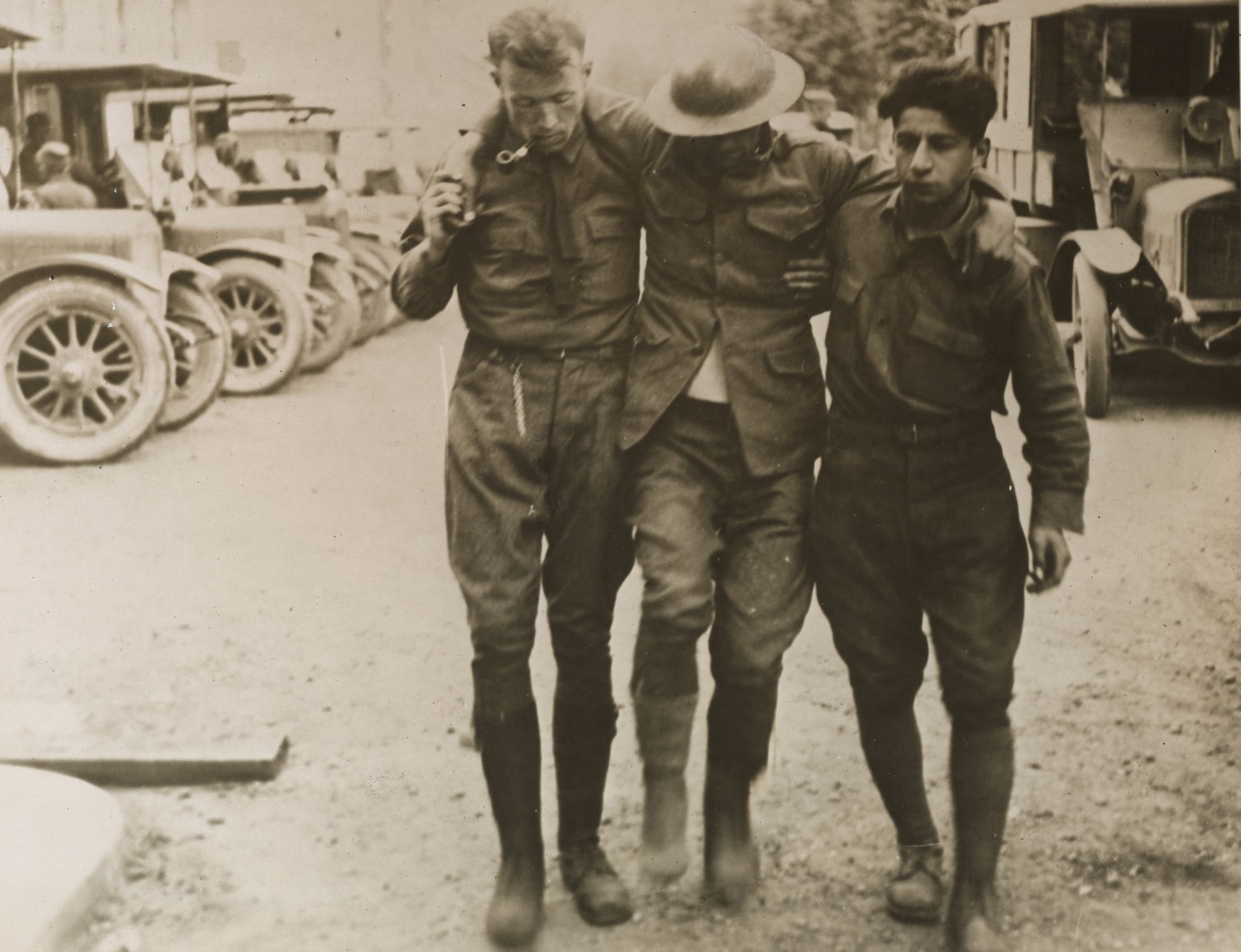
American Wounded arriving at American Base Hospital at Neuilly France
National Archives Identifier: 45493962